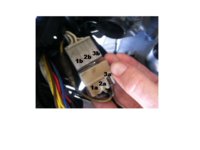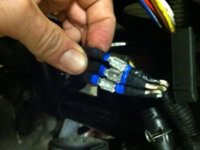tkurt
XS650 Addict
Hi All,
I recently installed a new vr-115, homemade rectifier and digital voltmeter (connected to a brown wire in the headlight bucket).
Problem 1: My digital voltmeter reads .5V less than battery (new and fully charged). Is this too much of a drop? I would suspect the ignition switch, but can't actually find one. The individual wiring connections have zero resistance.
Problem 2: If I do the feeler gauge "slap test" I only get weak magnetism at the rotor, and my positive brush only measures 10.7V with the bike on. The resistance of the rotor measures 5ohms between rings and infinity between either ring to ground.
I started tracing connections back from the brushes, and found that I lose a little over 1V from the brown wire TO the regulator and the green coming FROM the regulator. My guess is my regulator is shot (I think I may have shorted it when installing), but was hoping for confirmation before I buy a new one. Any thoughts?
Thanks!
I recently installed a new vr-115, homemade rectifier and digital voltmeter (connected to a brown wire in the headlight bucket).
Problem 1: My digital voltmeter reads .5V less than battery (new and fully charged). Is this too much of a drop? I would suspect the ignition switch, but can't actually find one. The individual wiring connections have zero resistance.
Problem 2: If I do the feeler gauge "slap test" I only get weak magnetism at the rotor, and my positive brush only measures 10.7V with the bike on. The resistance of the rotor measures 5ohms between rings and infinity between either ring to ground.
I started tracing connections back from the brushes, and found that I lose a little over 1V from the brown wire TO the regulator and the green coming FROM the regulator. My guess is my regulator is shot (I think I may have shorted it when installing), but was hoping for confirmation before I buy a new one. Any thoughts?
Thanks!

 .
.
